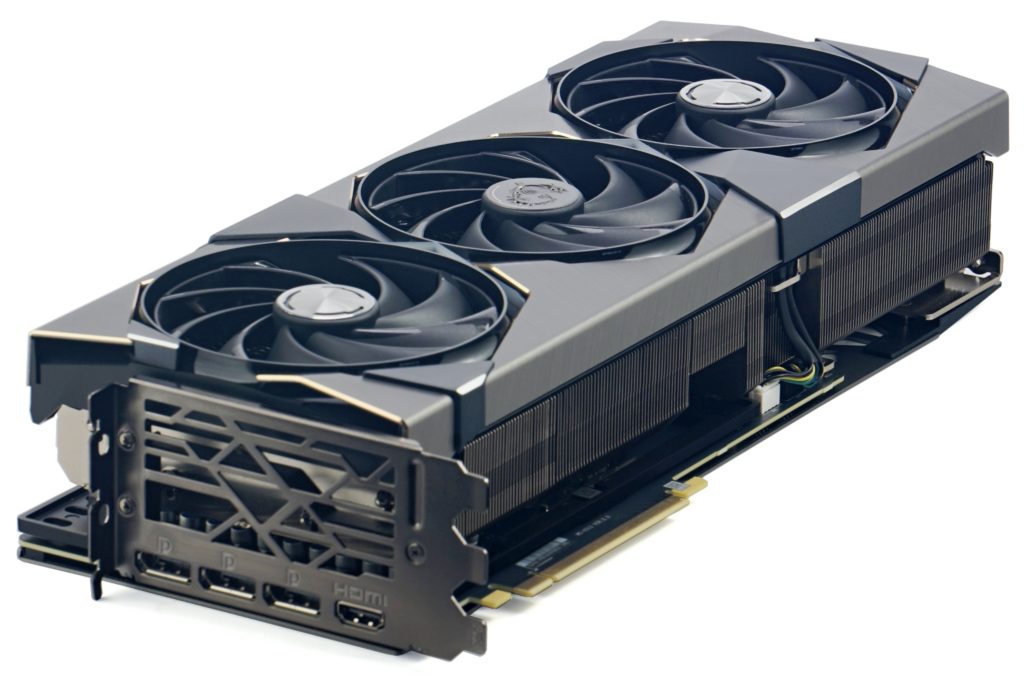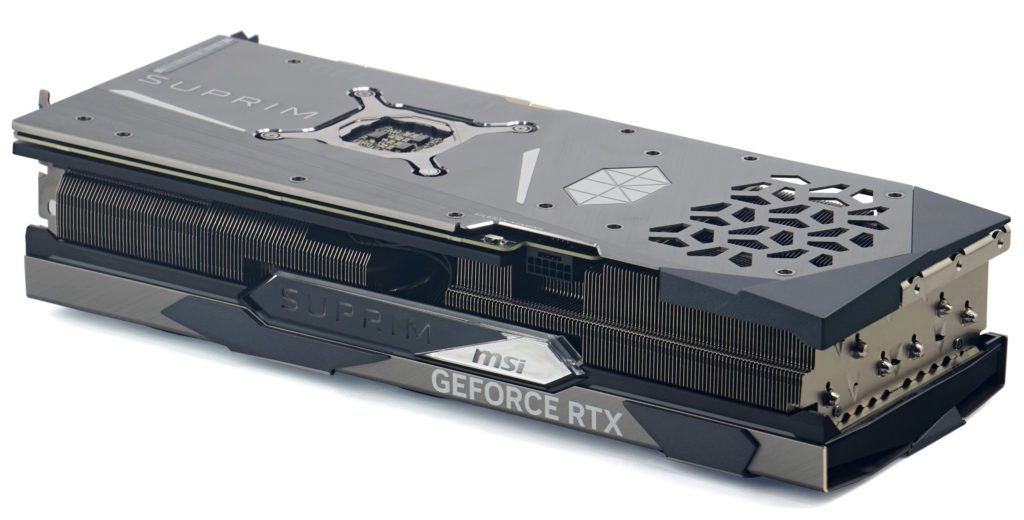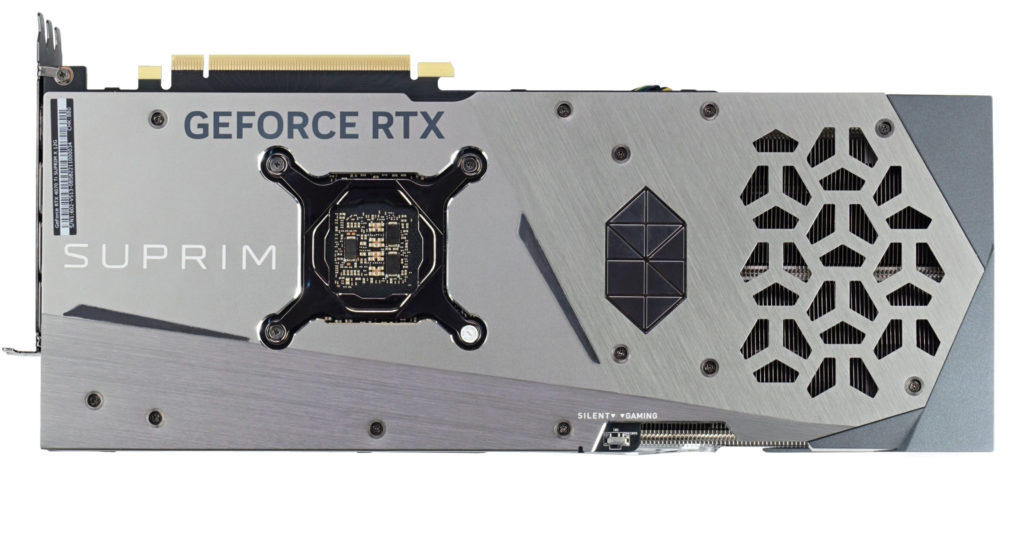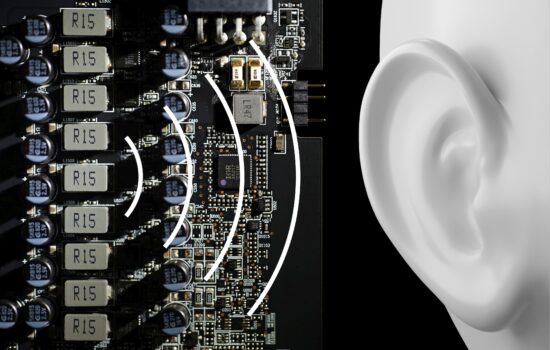MSI RTX 4070 Ti Suprim X 12G in detail
After the GeForce RTX 4080 graphics cards, which wasn’t to many people’s taste due to the higher price, Nvidia has released a significantly cheaper GPU for the GeForce RTX 4070 Ti. The performance versus the RTX 4080 is admittedly noticeably weaker, but percentage-wise not by as much as the roughly two-thirds lower price of the RTX 4070 Ti. In our tests, we analyze MSI’s non-reference design from the top-of-the-line Suprim series.
Nvidia was probably right to abandon the original plan with two RTX 4080s, where one (with a better-equipped GPU and 16GB of VRAM) was supposed to be more powerful and the other (12-gigabyte) slower. The latter, even in terms of better orientation, fits better with the final RTX 4070 Ti designation. This graphics card is built on the AD104 chip, which at 295 mm2 is approximately 22% smaller in area compared to the one (AD103) in the RTX 4080. The RTX 4070 Ti is also “stripped” in this ratio by SM blocks (60) and has 7680 shaders. In terms of clock speed, however, the GPU in the RTX 4070 Ti is always faster, the base clock speed is higher by 105 MHz (2310 MHz). In practice, however, the clock speed is usually significantly higher – MSI guarantees at least 2775 MHz for the tested Suprim X variant in boost.
One of the main differences of the RTX 4070 Ti over the RTX 4080 is the size of the video memory, it is 4 GB smaller (12 GB), but still fast GDDR6X modules are used. However, they are connected with “only” a 192-bit bus, so the bandwidth is ultimately lower by almost 30%.
MSI RTX 4070 Ti Suprim X 12G in detail
From some, let’s say more general parameters, we’ll move on to more specific details regarding MSI’s flagship design – the Suprim X. Besides it, MSI also has cheaper variants, the Ventus 3X (OC) and the Gaming (X) Trio (even in white), but the fastest option with the most effective cooler is embodied by the Suprim X. Alternatively, a Suprim without the “X” is also available with the same cooler with slightly lower clock speeds.
The body of the RTX 4070 Ti Suprim X is huge. It is 338 mm in length and 73 mm in height. The cooler has a slightly (proportionally to the lower TDP) lower profile than the RTX 4080 Suprim X, but you still have to take into account that the graphics card will occupy three PCI Express slots in addition to its own. Manufacturers of motherboards (and especially Gigabyte) optimize their motherboards quite well with regard to “thick” graphics cards – the second PCIe slot usually keeps a good distance from the first one and the space in between is efficiently filled by M.2 positions for SSDs.
Finally, there is one more dimension on which compatibility with the case depends – the width. This is 142 mm for the RTX 4070 Ti Suprim (X). For most cases, this is not a measure that exceeds the supported value, but for models with a vertically split interior into two parts, be cautious. In these cases, the graphics card may already be colliding with the side panel of the case.
The Tri Frozr 3S cooler includes three 95 mm fans. What is remarkable about them is that the tips of the blades are connected in threes by a sort of frame. This has mainly a reinforcing role and eliminates undulations at the ends of the blades. This not only reduces vibrations, but also suppresses resonant sound frequencies that make the user experience unpleasant.
Most of the card shell is metal, made of aluminum. Backplate and front part between the fans. The plastic elements (parts with darker color) are in the minority and are always characterized by high strength (it is a properly hardened material). All parts fit well together and the overall impression of the build is very good, the Suprim X defends its place in the class of the most expensive designs quite easily.
External power is provided by a single 16-pin (12VHPWR) connector with Astron hollows. Although these are the ones with smaller contact area (with pins) with higher transient resistance, the adapter is suitable due to lower power draw. This is evidenced by the thermal imaging tests we did with the more powerful RTX 4080 Suprim X with the same adapter in the box.
The ARGB LED backlight is on three sides. The light-guiding strips are between the fans, on the side (with the Suprim lettering and MSI logo backlit), and finally on the back where the Suprim logo is illuminated, a formation made up of triangular tiles that symbolizes a diamond as a sign of premiumness.
The accessories include, in addition to the power adapter, a Suprim-themed mouse pad, but most importantly, a height-adjustable support bracket. This supports the graphics card from behind to keep it level and not overly burden the PCI Express slot. MSI’s “holder” is sturdy and, thanks to the rubber base, stable even when handling the whole computer.
Please note: The article continues with following chapters.
- Contents
- MSI RTX 4070 Ti Suprim X 12G in detail
- Table of parameters
- Methodology: performance tests
- Methodology: how we measure power draw
- Methodology: noise and sound measurement
- Methodology: temperature tests
- Test setup
- 3DMark
- Age of Empires II: DE
- Assassin’s Creed: Valhalla
- Battlefield V
- Battlefield V with DXR
- Borderlands 3
- Control
- Control with DXR and DLSS
- Counter-Strike: GO
- Cyberpunk 2077
- Cyberpunk 2077 with DLSS
- Cyberpunk 2077 with DXR (and DXR with DLSS)
- DOOM Eternal
- F1 2020
- FIFA 21
- Forza Horizon 4
- Mafia: DE
- Metro Exodus
- Metro Exodus with DXR and DLSS
- Microsoft Flight Simulator
- Red Dead Redemption 2 (Vulkan)
- Red Dead Redemption 2 (Dx12)
- Shadow of the Tomb Raider
- Shadow of the Tomb Raider with DXR
- Total War Saga: Troy
- Wasteland 3
- Overall gaming performance and performance per euro
- CompuBench (OpenCL)
- SPECviewperf 2020 and SPECworkstation 3
- FLOPS, IOPS and memory speed tests
- 3D rendering 1/2 (LuxMark a Blender@Cycles)
- 3D rendering 2/2 (Blender@Radeon ProRender and Eevee)
- Photo editing (Adobe Photoshop, Lightroom and Affinity Photo)
- Broadcasting (OBS and Xsplit)
- Password cracking
- GPU clock speeds
- GPU and VRAM temperatures
- Net GPU power draw and performance per watt
- Analysis of 12 V branch power supply (higher load)
- Analysis of 12 V branch power supply (lower load)
- Analysis of 3,3 V branch power supply
- Noise level
- Frequency response of sound
- Conclusion





















